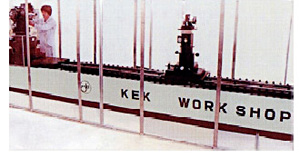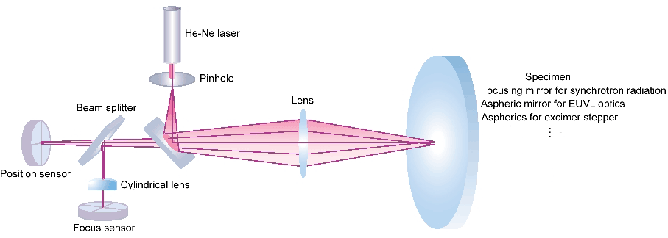|
 |
 |
Ultra-precision Aspheric Surface Measurement |
 |
|
 |
| Generally, there are many commercially available interferometric instruments, which can provide a 3D surface profile of an optical specimen. However, such instruments usually measure the relative difference in surface profiles between the sample and the reference mirrors. Consequently, these instruments have been limited in their practical applications. Furthermore, the accuracy of their measurements depends on the surface profile of the reference mirror. In our currently designed ultrahigh precision profiler, the need for a reference mirror is eliminated. The principle of this measuring method is as follows. The normal vectors at each point on the surface are determined by focusing the incident light beam on the mirror surface and the reflected beam at a coincident point. The surface gradients at each point are calculated from the normal vectors and the surface profile is obtained by integrating the gradients. By determining the normal with an accuracy of 5x10-8 radian, the surface profile can be calculated on the nanometer scale. The main features of the present measuring method are as follows. (1) The need for a reference surface is eliminated. (2) Any surface shape can be measured. (3) The aperture can be of any size. This method is called SGITP (Surface Gradient Integrated-Type Profiler), which has been developed and evaluated in collaboration with KEK (High Energy Accelerator Research Organization). |
In the present scheme, the incident and reflected light beams at every measurement point on the mirror are coincided, which is called the "common path" type. Therefore, the measurement accuracy is not influenced by the fluctuation of air index induced by the change of temperature and humidity in the light beam orbit. The measuring instrument is composed of an optical system, a specimen holder, and ultraprecise stages for controlling the alignment of each element. Furthermore, it is installed in a clean room where temperature and humidity are carefully controlled in order to preserve the integrity of the measurement.
|
 |
| Our center has developed numerous optical instruments with excellent performances by plasma CVM and EEM. The practical applications of these instruments are as follows. (1) X-ray interferometers and X-ray microscopes for 3rd- and 4th-generation high-coherency SR, (2) low-loss mirrors of interferometers for gravitational wave telescopes, and (3) aspheric mirrors for soft X-ray lithography. The profiler can evaluate surface profiles of either premachined or machined samples. Therefore, this is a key technology for excellent optical fabrication. |
 |
| |
| |
| |
| |
|

